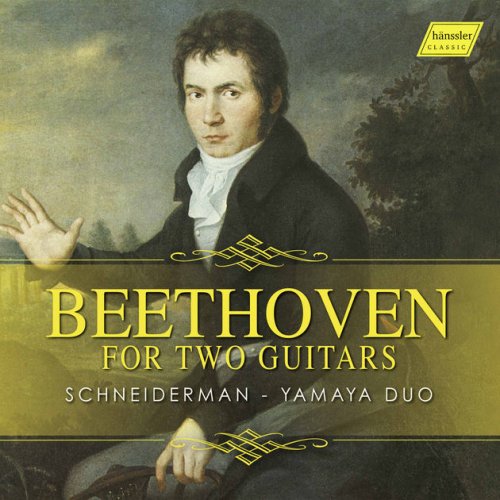
John Schneiderman & Hideki Yamaya - Beethoven for 2 Guitars (2017)
BAND/ARTIST: John Schneiderman, Hideki Yamaya
- Title: Beethoven for 2 Guitars
- Year Of Release: 2017
- Label: haenssler CLASSIC
- Genre: Classical
- Quality: flac lossless
- Total Time: 01:05:43
- Total Size: 215 mb
- WebSite: Album Preview
Tracklist
---------
01. Variations for 2 Guitars, Op. 3 (After Beethoven's Septet in E-Flat Major, Op. 20)
02. Rondo in G Major, WoO 41 (Arr. I. Klinger for 2 Guitars)
03. Andante for 2 Guitars, Op. 5 (After Beethoven's String Quartet No. 9 in C Major, Op. 59 No. 3)
04. Andante varié et rondeau, Op. 155 (After Beethoven's Piano Sonata No. 12 in A-Flat Major, Op. 26)
05. Variations on a Quartet by Beethoven for 2 Guitars, Op. 4
06. Piano Sonata No. 15 in D Major, Op. 28 "Pastoral" (Arr. for 2 Guitars)
07. 4 Waltzes for 2 Guitars (After L. Van Beethoven's 6 Waltzes, Anh. 14)
08. Fantasy for 2 Guitars, Op. 157 (After Beethoven's 9 Variations on "Quant'e piu bello", WoO 69)
So writes the 28 year-old Beethoven in 1798-1799 in a note to his trusted friend Baron Nikolaus Zmeskall, imploring him to ask their friend Karl Friedrich Amenda to send singer/guitarist acquaintance Gottfried Heinrich Mylich to visit him. Among his earliest friends in newly arrived Vienna, Beethoven had both personal and professional relationships with guitarists including Raimund von Wetzler, Austrian government official and musicologist Raphael Georg Kiesewetter, Countess Maria Wilhelmine von Thun. Besides these affable friendships, Beethoven also pursued love interests with women who had connections to the guitar, including Antonie Brentano, Therese Malfatti, Countess Maria Carolina Anna von Thun, and Regina Hitzelberger-Lang. Despite, or maybe because of Beethoven's acquaintance with casual guitarists, he did not compose for the guitar: perhaps his encroaching hearing loss did not enable him to value guitar performances, perhaps teh instrument was not sonorous enough for his interests, or perhaps he did not cultivate the direct personal associations with professional players necessary to master an unfamiliar medium. His four compositions for mandolin and harpsichord of 1796 are a natural resutl of his experience with string writing prompted by personal patronage. Alongside informal awareness of the guitar, professional virtuoso performers also moved within Beethoven's circle in immediate and indirect contact.
---------
01. Variations for 2 Guitars, Op. 3 (After Beethoven's Septet in E-Flat Major, Op. 20)
02. Rondo in G Major, WoO 41 (Arr. I. Klinger for 2 Guitars)
03. Andante for 2 Guitars, Op. 5 (After Beethoven's String Quartet No. 9 in C Major, Op. 59 No. 3)
04. Andante varié et rondeau, Op. 155 (After Beethoven's Piano Sonata No. 12 in A-Flat Major, Op. 26)
05. Variations on a Quartet by Beethoven for 2 Guitars, Op. 4
06. Piano Sonata No. 15 in D Major, Op. 28 "Pastoral" (Arr. for 2 Guitars)
07. 4 Waltzes for 2 Guitars (After L. Van Beethoven's 6 Waltzes, Anh. 14)
08. Fantasy for 2 Guitars, Op. 157 (After Beethoven's 9 Variations on "Quant'e piu bello", WoO 69)
So writes the 28 year-old Beethoven in 1798-1799 in a note to his trusted friend Baron Nikolaus Zmeskall, imploring him to ask their friend Karl Friedrich Amenda to send singer/guitarist acquaintance Gottfried Heinrich Mylich to visit him. Among his earliest friends in newly arrived Vienna, Beethoven had both personal and professional relationships with guitarists including Raimund von Wetzler, Austrian government official and musicologist Raphael Georg Kiesewetter, Countess Maria Wilhelmine von Thun. Besides these affable friendships, Beethoven also pursued love interests with women who had connections to the guitar, including Antonie Brentano, Therese Malfatti, Countess Maria Carolina Anna von Thun, and Regina Hitzelberger-Lang. Despite, or maybe because of Beethoven's acquaintance with casual guitarists, he did not compose for the guitar: perhaps his encroaching hearing loss did not enable him to value guitar performances, perhaps teh instrument was not sonorous enough for his interests, or perhaps he did not cultivate the direct personal associations with professional players necessary to master an unfamiliar medium. His four compositions for mandolin and harpsichord of 1796 are a natural resutl of his experience with string writing prompted by personal patronage. Alongside informal awareness of the guitar, professional virtuoso performers also moved within Beethoven's circle in immediate and indirect contact.
Year 2017 | Classical | Instrumental | FLAC / APE
As a ISRA.CLOUD's PREMIUM member you will have the following benefits:
- Unlimited high speed downloads
- Download directly without waiting time
- Unlimited parallel downloads
- Support for download accelerators
- No advertising
- Resume broken downloads


